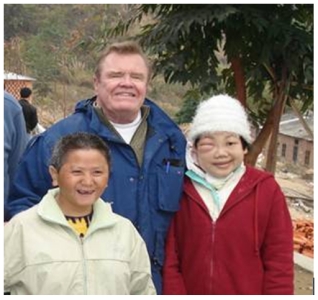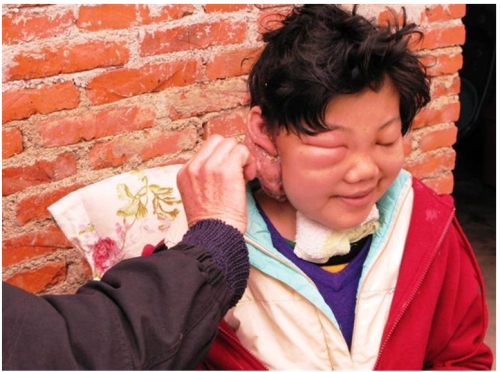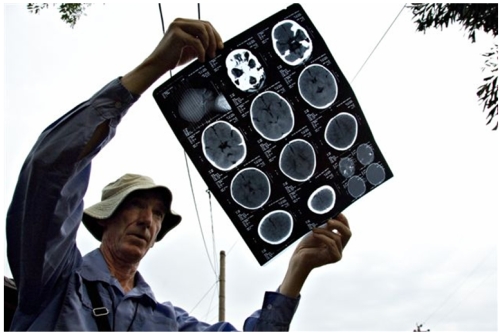Somewhere within the interior of China there is a city bustling with energy: manufacturing, corporate commerce and consumer retail. A thin coat of dust descends upon the urban valley, the result of frantic industrialization……..and upon a hill overlooking the city a solitary wisp of a woman, alone, dances contently, serenely.
 Angie (white jacket), Larry McElroy, Lena (red jacket)
Angie (white jacket), Larry McElroy, Lena (red jacket)
Within this large city is an area, rather pedestrian compared to other sections, dominated by small apartments, strip shopping, open restaurants, and several motels. Motorbikes outnumber the buses and autos. There are two farmers’ markets, the first, beneath a tin roof; the second, outdoors along the curb. It is crowded, so bikes and vehicles flow slowly, twisting and turning ever so closely to the produce, lest they leave tire marks over the ends of the carrots, stalks of celery and fruit. And, above this district looms the hill , full of rivulets, ruts, rocks and gravel, overshadowed by a high, wide slope full of vegetation, a natural backdrop to the woman’s dancing quite effortlessly.
The dirt road is the means of entrance to and exit from the line of red brick, one-room huts that occupy the top of the hill. Fr John, O.M.I. and his colleagues traverse this route daily as they minister to the occupants of the huts: two classrooms for primary students too poor to attend the public schools, a makeshift clinic tended by Rosa, a lay person called “the healing lady.” Separate homes for three women and the priest extend nearly to the end of the path. And, outside, along these huts, a young woman of twenty, with half her head swathed in gauze, unknown by the citizens below, can be seen dancing slowly, rhythmically.
Her name is Lena, abandoned at birth, perhaps because of poverty or perhaps because of the unsightly tumor dominating her baby face….or both, she was raised by distant relatives until she was older. As Lena grew to adulthood, the tumor accompanied her, longer, wider, lumpier and smellier, enclosing her right eye, ear, cheek and part of the neck. The rest of her body shows the agility of youth, as she moves freely about the huts and the walk.
Lena is not totally alone. She has Fr.John as her next-door neighbor; Rosa, “the Healing Lady,” a lay worker who resides in town with two retired sisters in an apartment fashioned simply but warmly, a place for meals for the priest and any other guests; plus several teachers who labor in the two classrooms, teaching the students what they can. She also has Mary, a young mother of a newborn, abandoned by the father of the child; she resides next door. Finally, there is Angie, an older, smallish woman with flecks of gray hair, whose name and place of birth are unknown. She is mentally deficient, with a recurring sore on the side of her mouth and eyes which focus inattentively. Who knows how much she knows. She was literally scraped off the street, quite homeless and neglected, but now apparently content to shuffle along back and forth in rubber boots probably too big for her feet. She often seems to smile as she watches Lena humming and dancing outside the huts.
Routinely, Fr. John or the “Healing Lady” change Lena’s bandages. Often there is a stench that permeates their clothes for the rest of the day after they gently swab the area behind her ear, absorbing the infection that oozes from the tumor. Angry, but more saddened at the apparent injustice of it all, the priest relates how Lena posed a constant problem to the staff at the local public hospital: no money to pay, the pungent stench, upsetting both the nurses and the other patients, plus the utter hopelessness felt among the doctors, that despite all of the measures taken, nothing else could be done, for she was destined to eventually die. Yet, Lena continues to dance.
From Australia, Fr. John imported patches containing maggots to devour the putrid flesh and pus, but this batch of parasites died, so the two care-givers regularly apply an astringent, or powder to dry up what they can, wash that side of her face, reapply fresh gauze. Then, one or both and whomever is present lay their hands upon her black, silken hair and pray for healing because that, among other things, is their thing; that is what missionaries and their companions do. As for Lena, her left eye, a brilliant onyx, shines brighter.
Somewhere in Southern China, there is a city, bustling with cacophonous noise, the ubiquitous smell of industrial dust silently covering the landscape. The doctors are seeing patients and dispensing prescriptions, nurses taking temperatures and dispensing pills….and above on the hill, Mary is nursing her newborn, Angie, apparently smiling, is gazing at Lena. As Fr. John relates to those present, Lena is deeply spiritual. She will succumb to the disease, but in the meantime, she is serenely dancing with God.
Larry McElroy, Feb. 29, 2008














